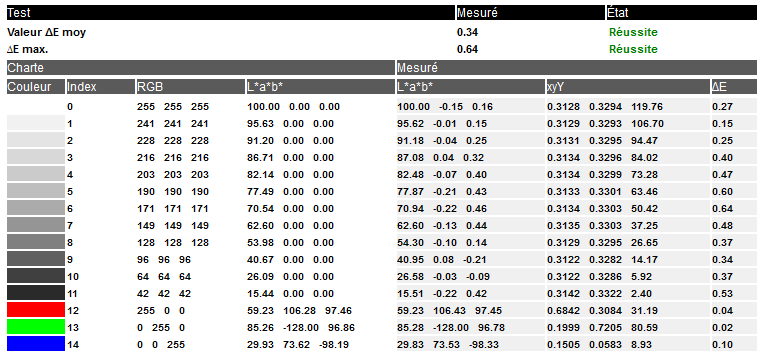Of the importance of measuring the homogeneity when testing a monitor
This post will be about screen quality and how online reviews almost always fail to give insightful information about an important metric: their homogeneity.
If you are planning to buy a new monitor for your computer, no doubt that you will read tons of reviews, hoping they will help you to make an enlightened choice. Depending on your use case, some metrics will bear more importance than others. Gamers will privilege high refresh rates, while graphic artists will be attentive to color rendition and some mysterious things such as color space.
Color accuracy and white point
Nowadays, every specialized tech website will test and report the color accuracy of the reviewed monitor. Which is good, as it was not always the case. The principle is to measure the deviation between the colors that were asked to be displayed from the colors actually displayed. That is done by using an independent and accurate hardware device: a colorimeter.
Here is the kind of report produced.
 These values are quite good!
These values are quite good!
Usually, we admit that, for a particular color, a DeltaE < 2 is invisible to the naked eye.
Another important measure is the white point, expressed in Kelvin. It is the color temperature of the illuminating source. How does that translate in real life? On a bright sunny day at noon, the “white light” received on the ground lies around 5400K. On an overcast day, it is closer to 6000K or even 7000K: the light is bluer. An old incandescent light bulb emits around 2800K, which is a very warm (=yellow) light.
Thus, when a photographer sets the color temperature to 6500k, he is wishing that the rendering of his photos approximates what they would be if printed and watched under a cloudy sky.
The colorimeter can also measure the deviance of the screen from the intended color temperature. It tells me that it is around 45K far of the target (less that 1%).
Given these two reports, this screen must be close to perfection!
IT IS NOT!!!
Where are the homogeneity results?
The problem is that the colorimeter was placed at the center of the screen. Thus, all you can know by reading those reports is that this monitor features very good color accuracy in the center!
What’s the situation in the corners? If deviance is too high, you may see a color shifting when filling the screen with white pixels! Fortunately, my colorimeter software also allows me to measure the color temperature at nine different places. And the results follow:
 The white point is perfect dead center. Not so much in the sides and corners.
The white point is perfect dead center. Not so much in the sides and corners.
In this report, there is a 200K difference between the left side and the right side. This is enough to be perceived with a naked eye!
And I could not measure the green / magenta tint deviation, which I can easily notice on the unit I tested.
Why is this information missing in most online reviews?
Why do the reviewing sites spend time to measure color accuracy, but never uniformity? I don’t know. It may be because moving the colorimeter is a manual operation. But without a measure of homogeneity, the provided information is incomplete.
Don’t bear me wrong. It is incomplete, but not useless: it gives a clue concerning the general quality of a screen. But if color accuracy matters to you, next time you’ll be in search for a new screen google a bit about the uniformity before purchasing. Some screen are given very good reviews across the board, but are a disappointment to many photographers.
Here is a catastrophic sample of BenQ sw2700pt. The colors are as they appear when displaying a white page!
 A very bad unit, but hey, it is accurate in the center!
A very bad unit, but hey, it is accurate in the center!
The BenQ sw2700pt has a real problem of homogeneity on most units. But if you only read one or two reviews, and don’t crawl the personal blogs and specialized forums, you may never know before buying one and turning it on!
